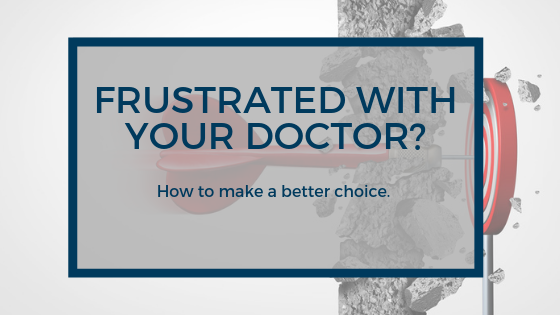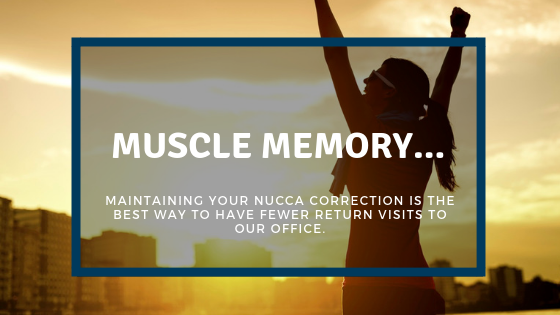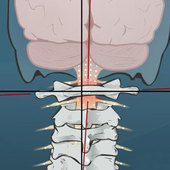- Home
- Looking For Help
- Team
- Community Initiatives
- Blogs
- Contact
- For Health Professionals
Conquering Lower Back Pain
How to make your pain get out and stay out!
 Taking action to keep an issue from happening in the first place is called primary prevention, but most of us struggle with that level of proactivity. When a patient presents to our clinic during a period of suffering after primary prevention is ignored, fails, or just wasn’t possible, they often express a willingness to do anything we suggest in the hopes that their situation will improve.
Taking action to keep an issue from happening in the first place is called primary prevention, but most of us struggle with that level of proactivity. When a patient presents to our clinic during a period of suffering after primary prevention is ignored, fails, or just wasn’t possible, they often express a willingness to do anything we suggest in the hopes that their situation will improve.
There seems to be endless funds available to research how to fix a problem, but what about keeping it away once it’s resolved? For some people, only one episode of an issue is enough for them to be proactive from then on. Most of us, though, once we feel better, have trouble prioritizing proactivity to keep the problem from recurring.
What should I do?
If you’ve skipped the primary prevention and find yourself with an issue, secondary prevention is taking action to minimize the likelihood of a recurrence of a previous problem. In our office, we call this phase Recovery Care (RC), and this is typically engaged once initial symptoms are reduced. Most patients choose to begin this care, but unfortunately, failure to follow through is something we see regularly. Almost half of our patients that noticed significant improvement in their symptoms never make it through the transition from simply resolving their symptoms to recovering from them. Resolving symptoms means that the situation is controlled enough that you are no longer hurting, while recovery involves minimizing the underlying dysfunction as completely as possible.
Clinically speaking, problems will likely recur unless the underlying dysfunction that contributed to the development of the problem is managed properly; typically, this isn’t accomplished until after symptoms are sufficiently resolved. Unfortunately, by then, many people have, understandably, moved on to prioritizing something else. This wouldn’t be an issue if the likelihood of recurrence wasn’t so high in spinal-related conditions.
What are the next steps?
 Since the rule for symptoms associated with a spinal injury is recurrence, our job is to minimize the likelihood of relapse and maximize the capability of the body to manage an issue if it re-appears. This ultimately involves a level of proactivity that is challenging for most patients to prioritize. The sad reality is that injured areas never heal completely back to the strength they were before the injury. Some patients’ injuries are mild enough that they can comfortably compensate and can be released from active care. After recovery, some patients choose to shift to Maintenance Care (MC) to minimize the likelihood of a future recurrence.
Since the rule for symptoms associated with a spinal injury is recurrence, our job is to minimize the likelihood of relapse and maximize the capability of the body to manage an issue if it re-appears. This ultimately involves a level of proactivity that is challenging for most patients to prioritize. The sad reality is that injured areas never heal completely back to the strength they were before the injury. Some patients’ injuries are mild enough that they can comfortably compensate and can be released from active care. After recovery, some patients choose to shift to Maintenance Care (MC) to minimize the likelihood of a future recurrence.
What is Maintenance Care?
Maintenance care is meant to stop a severe regression of the condition. This type of care may consist of periodic examinations to determine whether the patient may benefit from chiropractic adjustments to eliminate structural imbalances.
There are those patients that never completely recover and are left with an ongoing issue, and in these cases, we engage tertiary prevention to proactively take action to minimize the impact of an existing problem. In our office, this phase is called Supportive Care (SC). The objective of Supportive care is to prevent recurrence or reactivation of the condition and thus keep the patient productive in his/her occupation or activities.

To put this in perspective, I recently had a long-time patient inadvertently put this to the test. For years he came in regularly for a check-up to keep chronic symptoms of a severe injury manageable (tertiary prevention). For some reason, he decided to veer off his normal proactive supportive visit frequency (a check-up every couple of months) to see if he could manage on his own without intervention. Within 12 months, this experiment had the unfortunate consequence of him suffering with gradually increasing pain, and he eventually returned to the clinic for an appointment. His lack of proactivity caused us to need many appointments as we worked to help calm the dysfunction and associated symptoms caused by a year of neglect. As a result of the recurrence of pain, this patient’s ‘experiment’ served to reinforce that what he had been previously doing to manage the dysfunction allowed him to stay ahead of the issue. This worked better for his body than just reacting when things were no longer tolerable.
You see, the real job after an issue is fixed is to manage it with as few visits as possible while keeping things as good as possible. It’s sort of counterintuitive that if we do our job really well, we actually want to see you less often!
Maintenance Care – let’s do this!
Recently, the chiropractic profession in Norway contributed some research to our understanding of the benefit of maintenance care (Eklund et al. Chiropractic & Manual Therapies (2020)). They defined maintenance care as “receiving care at regular pre-planned intervals regardless of symptoms”. They found that those in their study that were “receiving MC had flat pain trajectories around each new treatment period and reported fewer days with pain compared to patients receiving the control intervention.” The control intervention in this study entailed waiting for a problem to happen and then reacting by making an appointment.
We are all familiar with maintenance care in dentistry, and that works well and is widely accepted in our society. Almost everyone will experience back or neck pain in their lifetime, so being proactive to try and minimize the likelihood of pain associated with spinal dysfunction makes sense. Our job is to support you in making a decision that best fits your life, and we want to help you manage your condition with minimal care. We recognize that prioritizing being proactive can be a big challenge. But, if we listen to the science as well as look back on our patient histories, it tells us that the rule is recurrence, and proactive management will typically cost less in the long run in both suffering and dollars.
Don’t ghost us, just call!
While considering preventative and maintenance care during our office’s strategic planning retreat in 2021, we created a new metric in our office. We’ve called it our ‘ghosting’ metric, and it measures the number of patients that pause their care without chatting with us or letting us know why they are making that decision. To minimize the number of patients that “ghost us”, we invite you to let us know if you feel ready to pause your care. We want you to know that our care is centred around your goals and your needs. If your goals are met or needs change, you might feel ready to be released from active care. When you feel that you’ve received enough care in our office, we will support you in that decision. If you need our help in the future, you’re always welcome to return.
 In the end, we are working to help you achieve your goals and minimize any interference in your life from spinal health challenges. Our goal is to facilitate our patient’s ability to maintain spinal balance for the rest of their life with as few adjustments as possible. Factors such as trauma, degenerative disease, and chronic misuse can weaken spinal integrity, either temporarily or permanently because of the spine’s functional nature. Therefore, maintaining spinal balance may require periodic care for some patients. It is truly in the best interest of the patient not to allow a functionally weakened area of the spine to progress to a symptomatic level if such can be prevented through examination and appropriate care if needed.
In the end, we are working to help you achieve your goals and minimize any interference in your life from spinal health challenges. Our goal is to facilitate our patient’s ability to maintain spinal balance for the rest of their life with as few adjustments as possible. Factors such as trauma, degenerative disease, and chronic misuse can weaken spinal integrity, either temporarily or permanently because of the spine’s functional nature. Therefore, maintaining spinal balance may require periodic care for some patients. It is truly in the best interest of the patient not to allow a functionally weakened area of the spine to progress to a symptomatic level if such can be prevented through examination and appropriate care if needed.
Just give us a call, we are always here to help!

Dr. Jeff Scholten
NUCCA Chiropractor
The Vital Posture™ Clinic
Calgary, Canada
Cutting through the confusion. What is health, and how do you get more of it?
 This past year, perhaps more than ever, we find ourselves thinking a lot about health. It is nearly impossible to get through a day without the media reporting on the grim health statistics of our fellow Canadians or without being asked about our own health status if and when we venture out in public.
This past year, perhaps more than ever, we find ourselves thinking a lot about health. It is nearly impossible to get through a day without the media reporting on the grim health statistics of our fellow Canadians or without being asked about our own health status if and when we venture out in public.
If health is so important, why is it so misunderstood?
Society has a problem because many people don’t really understand what it means to be healthy versus sick. When we hear news reports of ‘healthy’ people succumbing to Covid 19, we wonder if we too might become sick from this virus or whether the reports are exaggerated. The response of our society to this pandemic is not the subject of this blog, however, it offers an opportunity for us to explore the difference between being sick and being healthy.
Healthy – Heal thy self
Consider this for a moment: is someone with a fever healthy? Is someone who is nauseous healthy? Our media inundates us with commercials on how to reduce fever and gives the impression that fevers should be avoided, but I was taught during my undergrad that the increased body temperature that occurs with exercise - a febrile (fever) response - is one thing that keeps people who exercise protected against germs. Because germs like viruses and bacteria are temperature sensitive, a natural fever’s increase in temperature helps your body’s immune system fight the invaders. Between 2-5% of children below 5 years old will experience seizures from fever (1) which is understandably scary for parents if it was to happen to their child. Advertising for fever-reducing medication has preyed on this fear, and a false narrative about fever has caused much of our society to incorrectly view all fever as bad. While sometimes fever is bad, most often it is a healthy response that helps your body manage an invader, and suppressing it is actually unhealthy.

As for nausea, if you eat some bad food, wouldn’t suppressing the associated nausea actually be the wrong response? Not according to many medication advertisements. We need to understand that in this case you are not feeling nauseous because you are ‘sick’, you are feeling it as a healthy response to an unhealthy situation. Your body wants to naturally rid itself of a bad substance, which if left inside, could make you actually really sick!
In essence, there are many events related to our health and wellness that our body needs to respond to daily. Consider this story for a moment. The other day, a fellow health care practitioner was describing someone close to them that was recently hospitalized from a major blood vessel in their stomach rupturing (dissection of an aneurysm in the abdominal aorta). This condition is typically related to Atherosclerosis, and during chiropractic training we were taught how to examine for this possibility. As NUCCA practitioners, we see more than our fair share of patients with connective disorders such as Ehlers Danlos which can make a person more susceptible to aneurysms. Abdominal aortic aneurysms are often discovered in patients during routine physical examinations before they rupture, but for this young 40-year-old, their aneurysm was not discovered until they experienced the severe pain in the abdomen that is typical of a dissection. The question is, was this person healthy before the dissection, or not?
 Health is similar to the value of a piece of art; it is something that is measured in the moment of transaction. What you pay for art is its value at that particular moment in time. When your body responds to a health challenge successfully, by use of fever or nausea-induced vomiting for instance, you can be called healthy because you had a successful response at that particular moment in time. You see, as my daughter pointed out to me many years ago, healthy is a compound word – heal + thy. If you can heal yourself, you are healthy. If not, you aren’t – period. It is something that occurs in an event. Who you are (genetically), and what you have done before that event (eat well, exercise), is the crucial “training” that will go into whether or not you pass that test.
Health is similar to the value of a piece of art; it is something that is measured in the moment of transaction. What you pay for art is its value at that particular moment in time. When your body responds to a health challenge successfully, by use of fever or nausea-induced vomiting for instance, you can be called healthy because you had a successful response at that particular moment in time. You see, as my daughter pointed out to me many years ago, healthy is a compound word – heal + thy. If you can heal yourself, you are healthy. If not, you aren’t – period. It is something that occurs in an event. Who you are (genetically), and what you have done before that event (eat well, exercise), is the crucial “training” that will go into whether or not you pass that test.
In the earlier example, the 40-year-old was healthy and adapting well to his aortic aneurysm… until he wasn’t. With the assistance of doctors, he was able to recover from this pathology and the necessary surgery. Fortunately, he was healthy enough to be helped by modern medicine.
Optimize your health response – optimize your posture!
Just like you might have more patience with one person and not with another, you may be able to have a healthy adaptation to one event and not another. The essence is that healthy people never die; the very act of dying means that you could not heal yourself, and therefore you are no longer healthy. There are things that are harder, or nearly impossible, to adapt to for most people, and as intelligent humans we have invented things to help lessen the need to adapt. Things like parachutes and airbags increase the chance of our healthy adaptation (also called survival) to events such as jumping from a plane or involvement in a motor vehicle collision.
In our practice, we contribute significantly to our patients’ health. Quite simply, if your posture is asymmetrical in gravity, you will require more effort to maintain your position and therefore have less energy available for healing or adapting. Getting a check-up from your neck up helps to optimize your relationship with gravity and maximize your body’s ability to have a healthy response, should a situation arise. As a friend and colleague of mine often says, spinal health is the difference between an 80-year-old that can still be out on the golf course versus one that is housebound. Making sure your relationship with gravity is appropriate makes your body a better place to live over the long term. Proactive spinal hygiene helps you adapt to all sorts of health challenges, both big and small. Consider us your seatbelt!
Healing is helped by having a doctor that understands health
If you are suffering from a neck injury, you may begin to experience severe dizziness, headaches, and neck pain. Although neck pain specialists don’t exist in Canada yet, there are people who have different amounts of knowledge regarding diagnosing and helping people with neck problems.
At the Vital Posture™ Clinic, we focus on imbalances in the neck that, if left untreated, can result in neck pain and neck discomfort. Our focus is the neck; our intervention starts with NUCCA procedures and is augmented by our extensive post-graduate training in Advanced Imaging, Chiropractic Craniocervical Junction Procedures (www.icauppercervical.com), and Pain Management.
Trust us with your difficult neck injury
When you have a complicated neck issue that isn’t responding to conservative care, leave it to us to help gather a team that will allow you to find relief from your neck injury and recover.
- https://www.ninds.nih.gov/disorders/patient-caregiver-education/fact-sheets/febrile-seizures-fact-sheet#:~:text=Febrile%20seizures%20are%20seizures%20or,the%20second%20year%20of%20life.

Dr. Jeff Scholten
NUCCA Chiropractor
The Vital Posture™ Clinic
Calgary, Canada
Counting Sheep - How to Sleep Safely and Comfortably
A bad night’s sleep affects everything about your day. One of the first questions many patients ask us is how to optimize sleep position to minimize the stress on their neck. In order to capitalize on the quality of how you spend one-third of your day, you must consider your sleep position and picking the right pillow and mattress.
Neck and back pain continue to be the leading cause of years lived with a disability; combine that with an increasing percentage of people who are suffering, and making a smart decision around your sleep habits is critical. Many people wake up with neck pain and back stiffness, and starting the day that way is definitely not ideal.
Read more: Counting Sheep - How to Sleep Safely and Comfortably
Need help with home office hazards?
This is truly a historic time.
We find ourselves in the middle of a global phenomenon that has focused our awareness in an exceptional way. We have all likely developed an enhanced recognition that tomorrow has a very real possibility of being dramatically different than today, and many of the things we took for granted are no longer possible for an unknown amount of time.
For many of us, change can be a major challenge to our health. As we adapt to the physical, emotional, and financial challenges that have been brought about, a new and perhaps unusual working environment might very well cause us physical pain.
So you’re alive, now what? Re-introducing Secondary Vitals™
Creating Secondary Vitals (2◦V)
In 2011, while taking a graduate level course on the Nature of Pain, a comment was made by a fellow participant that the assessment of pain should be a vital sign. Vital signs typically consist of temperature, blood pressure, pulse, and breathing; when these are present, it means you’re alive.
Read more: So you’re alive, now what? Re-introducing Secondary Vitals™
Shoet: my neighbour made me do it!

Many of you that came into Vital PostureTM in August saw a growing pile of shoes in our reception area. Now why would we, a group of chiropractors, be collecting shoes?
At Vital PostureTM, we strive to provide excellence in management of challenges with injury to the upper neck and the resulting postural imbalances. What does this have to do with collecting shoes?
Frustrated with your doctor? How to make a better choice.

If you are one of many people frustrated with an experience in a doctor’s office, you’re not alone. Just like all relationships, not all patients and doctors belong together. Communication and social styles can play a big role in the level of satisfaction experienced by both patient and doctor.
Read more: Frustrated with your doctor? How to make a better choice.
Protect Your Neck: One easy thing everyone can do this winter
Read more: Protect Your Neck: One easy thing everyone can do this winter
Muscle memory—turn short-term relief into a lasting recovery!

Many patients presenting to our clinic relate how their actual injury occurred years before. In most cases, these patients’ bodies have adapted to their new asymmetrical position long before they see us. For patients to sustainably recover from difficult neck injuries, we need to understand muscle memory and make it work for us.
Read more: Muscle memory—turn short-term relief into a lasting recovery!
Is cracking your neck bad? Answers from a NUCCA chiropractor

If you crack your neck from time to time, you’re not alone! You know just how good it can feel to relieve that aching stiffness.
Read more: Is cracking your neck bad? Answers from a NUCCA chiropractor
Is your doctor wrong for you? Advice for neck pain and chronic conditions
The most dangerous doctor, aside from one that doesn’t care, is the one that thinks they know it all. Health care is complex, and delivery needs to be personalized and dynamic.
Read more: Is your doctor wrong for you? Advice for neck pain and chronic conditions
When you should be a bother…

It’s time to be a bad patient! In recent years, many health care consumers (possibly including you) have evolved beyond just doing what their doctor told them and have begun to ask questions. This involvement has created tremendous frustration in some authoritarian doctors that demand obedience from their patients.
Considering NUCCA Chiropractic? 7 things you need to know

Do you suffer from back, shoulder, or neck pain? Migraines? Maybe jaw pain? Have you tried various pain-reducing techniques over the years, only to experience disappointment over and over again?
Read more: Considering NUCCA Chiropractic? 7 things you need to know
Holding is Healing!
Just as ‘All-you-can-eat’ buffets typically don’t promote healthy eating habits, getting adjusted more often doesn’t typically create better health outcomes.
The creation of a seemingly magic solution #NUCCA
NUCCA is not quite old enough to deserve a pension, but it is certainly old enough to have some experience with life.
Read more: The creation of a seemingly magic solution #NUCCA
Health: Are you smarter than a Fifth-Grader?
How do you know if you’re healthy? Many people think they are healthy if they feel good. Although feeling good is important, and feeling badly can indicate that something is wrong, using how you feel as the only definition of health isn’t good enough.
Cracking the Chronic Pain Puzzle
Flush Away Chinook Pain!
One of the best parts about spending winter in Calgary is the break we’re given from the cold by our periodic chinooks.
Practice Makes Perfect
Whether it’s shooting baskets or reducing misalignments, the training never stops for a professional. Iron sharpens iron, and at The Vital PostureTM Clinic our doctors spend significant time each week training and learning together.





